ON THE TOWN… with Chip Deffaa …. October 28nd, 2018
Jonathan Larson had a lot to give the world. I watched Rent quickly find a mass audience, in a way that happens perhaps once in a generation. It opened Off-Broadway, in 1996, with an explosive energy, and I happily watched the audience respond in kind. It soon transferred to Broadway. And it was the hot ticket–much the way Hamilton would be, about 20 years later. When I attended the recording session for the original cast album, the feeling in the air was really strong (and different from any other recording session I’ve attended); everyone knew the album would be a huge hit. Interest in Rent and Larson was red hot.
It’s always a treat to see the premiere of good, strong, original work. And I’ve just witnessed two memorable premieres.
I caught the first full New York production of a new musical, Midnight at the Never Get, at the York Theatre. There’s much to relish in this production. And Mark Sonnenblick–a young Yale alumnus who wrote book, music, and lyrics–is certainly an artist-to-watch. More about that rewarding–and warmly recommended–show in a moment.
I also savored The Jonathan Larson Project, which packed New York’s top supper club, Feinstein’s/54 Below, for six nights. And even though Jonathan Larson–the Pulitzer Prize-winning creator of Rent–has been gone for 22 years, this too can be considered a premiere. Because some of the fascinating songs presented in this show have never before been performed in public. And while others received some extremely limited exposure during Larson’s lifetime, they will be brand new to all but the most dedicated of Larson followers today. And they deserve greater exposure.
Now, let me tell you a bit more about both of these productions….
* * *
The York Theater has long served as an incubator for new musicals; that’s its primary mission. Some of the new musicals work; many more don’t. That’s just the nature of the business. Their current offering, Midnight at the Never Get, is the best new musical I’ve seen at the York in a long time.
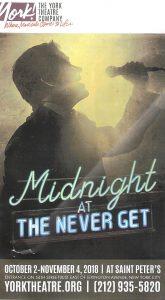
Midnight at the Never Get
Somehow, I’d heard no buzz about this show at all. I often hear something about shows well before they open. In any given show that I go to see in New York, there’s usually someone with whom I’ve worked in past years, or whom I know socially, or who’s worked with friends of mine, who says something to me about the show; it’s a small community, and word about new shows often travels fast. (And the York Theater has helped nurture a show or two of mine; so I have even more reason to usually follow closely what they’re working on.) But I’ve been in-and-out of town a lot this year, and preoccupied with some family matters. And somehow I missed hearing about this show.
I stepped into the York Theater knowing virtually nothing about Midnight at the Never Get, and took my seat with no expectations. What a wonderful surprise! Jim Morgan, who runs the York, has got a winner on his hands.
Mark Sonnenblick–who created the show–is a name to remember. His show, as presented at the York, is well-written, well-cast, well-directed; and handsomely produced. I think it has a bright future.

Mark Sonnenblick
Midnight at the Never Get is an intimate musical and it’s wholly original–not an adaptation of a film, play, or book. It’s fresh, insightful, and held my interest from beginning to end. I could not predict how it would end. That alone sets it apart from most of the dreck I see. (And I see a lot of shows I won’t waste time even writing about.)
This intriguing show also marks the Off-Broadway directing debut of Max Friedman, who’s served as Assistant Director of the high-spirited Be More Chill, which I loved. Sam Bolen (who co-conceived the show) stars as a singer, working in small New York clubs in the 1960s, who falls in love with a songwriter/pianist, played by Jeremy Cohen. It’s a love story of sorts, set in New York prior to the arrival of gay liberation. And the author explores wisely the ways in which we may recall, romanticize, interpret and re-interpret the past.
Both Bolen and Cohen are playing believable characters–Bolen as the fellow who’s all-too-eager to please his partner (the type of guy that guys will often tire of because–although he’s sincere and likeable– he’s just too devoted/clingy/needy).
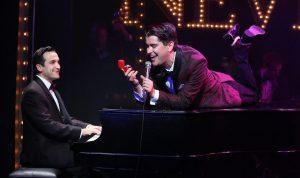
Sam Bolen and Jeremy Cohen
And Cohen has that armored effect that certain closeted gay males have. Cohen plays the part perfectly–even his body language is just right; he evokes a kind of guy that was once much more common (and is much less often seen nowadays), before gay liberation was fully realized. I felt like I’d met both Bolen’s and Cohen’s characters, that I’d known them both well in past years. I felt I really knew them, that we go way back. (And that’s a solid compliment to the playwright, director, and actors.) Cohen had so many small details exactly right–from the haircut to the tight smile, to the touch of passive-aggressiveness in his banter–it was almost frightening.
There’s also a terrific six-piece band, providing a smoky, sassy, brassy background. Kudos to music director/arranger Adam Podd, and the musicians.
I don’t think I’d change a thing on that stage. Well… if I wanted to be nit-picky, one passing reference in the show to “calling 911″ did momentarily pull me out of the story. Because no one was calling 911 in the mid 1960s; no one back then would have understood the term “911.” In the 1960s, if you needed the police, you dialed “O” for the operator; dialing “911,” I recall quite clearly, only came into use later. (One of my aunts, who was a telephone operator who periodically had to connect callers with the police, very much welcomed the introduction of “911,” even though it took a good decade or more to get it going through most of the country; the rollout took quite a long time.) But aside from that one very minor anachronism, the show evokes the era brilliantly.
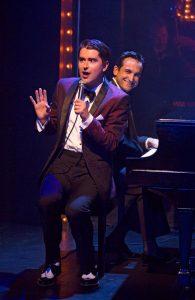
Sam Bolen and Jeremy Cohen
Midnight at the Never Get covers a lot of ground very well–love, loss, gay liberation. And at least one of the songs in the score is already turning up in a couple of performers’ cabaret acts. (And I’m sure it will turn up in more.) The production’s current run is a limited engagement, through November 4th. I’m hoping that the run may be extended or that the show might transfer to another venue. It merits greater life. And a cast recording. (I’d be among the first to buy it.)
Near the very end of the musical, the one-and-only Jon Peterson–who’s starred in shows in London and New York, and on tour–makes a brief but crucial appearance. It is almost a cameo–just one song. But his inimitable mix of depth, sensitivity, and presence adds considerable luster to the proceedings. They are lucky to have a star of his caliber giving the show an extra wallop at the end. (I’ve worked with Jon. He’s always rewarding, whether in large roles or small.) It’s a very brief turn, but it helps bring the show to an unexpectedly rewarding conclusion. It helps put an already-very-good-show over the top.
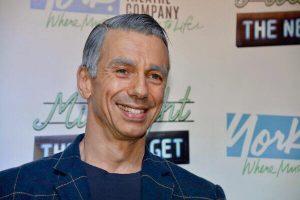
Jon Peterson in Midnight at the Never Get
May I add a note about Jon Peterson? Born and raised in England, he made his name in shows on the West End. He was brought over to the U.S. to star as the Emcee in the national tour of the musical Cabaret. He’s performed that role terrifically many times–on tour, in regional productions, in New York. He’s also starred in my own show George M. Cohan Tonight!, in New York, in many cities of the U.S., and abroad, and has recorded with me. He’s done assorted other shows, too, of course–from A Chorus Line to Half a Sixpence. Over the years, he’s received many honors, awards, accolades.
It’s good to see him making the most out of a small surprise guest-appearance here. But he is a star, capable of brilliantly carrying a musical by himself. Stars are few and far between. In an ideal world, Jon Peterson would be starring in some production or another right now, rather than doing this brief supporting turn. He’s excellent, of course, in this small role. And it’s a very good production. But–as Peterson has proven countless times over the years–he’s capable of much more. He really deserves starring roles in musicals, whenever opportunities might arise–roles that let him show all that’s he’s capable of.
* * *
The generous spirit of Jonathan Larson (1960-1996) certainly was felt in New York’s great supper club, Feinstein’s/54 Below, the night I went to see The Jonathan Larson Project (which filled the club for a dozen performances in six nights, with different guest-stars each night). It did my soul good to be there.
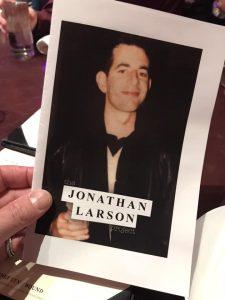
THE JONATHAN LARSON PROJECT program
We were treated to an array of little-known songs of Larson. Not the familiar songs from his famed musicals Rent and tick, tick… BOOM!, but largely unknown songs he wrote in the decade or so before Rent opened. Some of the songs have never before been performed in public. And there are some very good songs that I hope we may be hearing more in the future. It’s important to get them out there.
Director Jennifer Ashley Tepper gathered a first-rate cast to interpret the songs: Andy Mientus, George Salazar, Lauren Marcus, Nick Blaremire, Krysta Rodriguez. Music director/arranger Charlie Rosen led a hard-hitting six-piece band. And the company did Jonathan Larson justice. The whole production was honed to perfection, with the right singers chosen for the right songs. There were ensemble numbers, duets, solos, fully rehearsed and effectively staged.
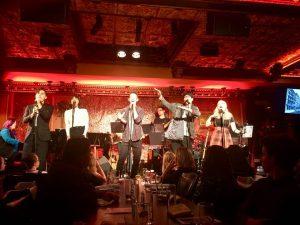
The cast of THE JONATHAN LARSON PROJECT
Special guest stars (including Anthony Rapp and Daphne Rubin-Vega, from the original cast of Rent, and Amy Spanger, from the original cast of tick, tick… BOOM!) performed at the shows, throughout the week.
I hope these concerts may yield an album. And I hope the album will include complete liner notes, with lyrics to all of the songs. (I want to spend time with the lyrics–some of which went by too quickly on first hearing in the club.) Larson was a huge talent. A well-produced album of Larson’s best “unknown” songs would be a significant addition to the Larson legacy.
Some of the songs I heard at Feinstein’s/54 Below–like “Greene Street,” “Destination Sky,” “Rhapsody,” “Love Heals,” “Piano,” and “Valentine’s Day”–work perfectly well by themselves. (And “White Male World” certainly feels timely, in the “Me, Too” era.) Other songs–written for very specific situations in musicals– probably need to be heard in context to be fully appreciated. But I’ve long hoped to see a concert like this, and Tepper did an outstanding job.
If I may interject a personal note… Sixteen years ago, I actually asked the agent representing Jonathan Larson’s interests if I could produce a concert of Larson’s unknown songs. I could not get the go-ahead at that time, and that concert evolved into “Jonathan Larson’s Musical Heirs,” hosted by my friend Karen Oberlin, who had been in an early workshop version of Rent. But I was happy to honor Jonathan Larson in some way–he was a tremendous artist–and I was glad that his father, Al Larson, and his former girlfriend, Victoria Leacock Hoffman, attended that show.
Jonathan Larson’s music has always spoken to me–as it has to so many others. And if more of his quality “unknown” songs can be brought to light, we’ll all be richer for it.
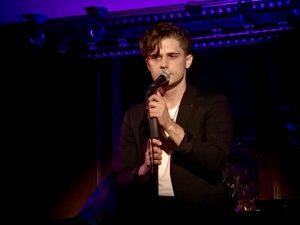
Andy Mientus
The concert at Feinstein’s/54 Below was done beautifully. Andy Mientus (whom you may recall from the NBC TV series “Smash”; he was a standout on that show as he was a standout here) was an ideal lead singer on “Valentine’s Day” (an excellent song that was cut from Rent). Such a gorgeous voice! He was effective, too–strong and penetrating in his delivery–on “S.O.S.,” which Larson wrote for a proposed musical adaptation of George Orwell’s 1984. (The Orwell estate would not give Larson permission to do a musical version of 1984; and that’s a pity, judging from this potent song.)
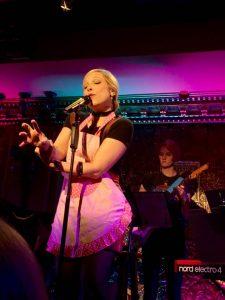
LAUREN MARCUS
Lauren Marcus and George Salazar–who are both so adorable playing teenagers in the musical comedy Be More Chill–got to sing songs that fit well their lively, outgoing personalities. I really like the care that Tepper took in figuring out which singers were the best matches, in terms of voices and personalities, for the different Larson songs.

GEORGE SALAZAR
Marcus had great fun putting over “Break Out the Booze,” an old-school musical comedy number Larson had written for a show set on the final night of prohibition. (Those who only know Larson from his pop/rock score for Rent might have been surprised to see he could also create more traditional types of theater songs well.) And she got to roam the house as she sang this piece–performing a bit of it, for example, standing right next to me. I enjoyed that a lot, too.
I especially loved the heartfelt purity of Matt McCollum’s work, singing “Destination Sky,” to his own guitar accompaniment. (Oh, he has to have a chance to record that!) It just touched me–so simple, direct, honest and true. I liked McCollum’s work so much, I was hoping he might do another number.
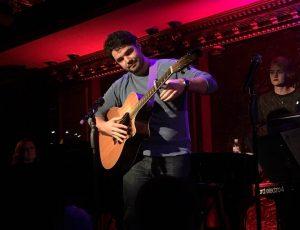
MATT McCOLLUM
Matt McCollum, incidentally, is a nephew of Jonathan Larson. And he’s a singer–new to me–I’d like to hear more from; he sings from the heart. (His brother Dylan also performed one night; but I was not able to attend that night.) One final treat was hearing a bit of Larson himself–a demo recording of him singing one of his own songs.
I was glad we were given detailed printed program notes (written by Tepper), which I was able to read after I got home. (It was not always easy for me to read them during the show, in the darkened house.) I would have welcomed also hearing some spoken commentary from the performers, between some of the numbers–to help better put some numbers in context; to help build a greater rapport between the performers and the audience; and to create more varied dynamics. Wine tasters will sometimes have a bit of sherbet between sips of wine, just to help cleanse the palate, so that they can better appreciate the wine. If they just drink one wine after another, the senses gradually get dulled. Hearing 19 unfamiliar songs in succession, without any spoken commentary in between, isn’t necessarily the best way to fully appreciate those
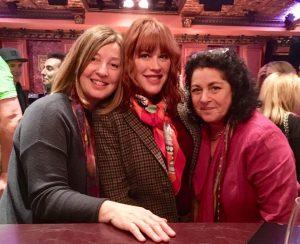
Victoria Leacock Hoffman, Molly Ringwald, Julie Larson
songs. Taking an occasional pause from the singing and letting the performers chat a bit, enables audience members to then hear subsequent songs with fresher ears, besides enabling them to get to know the performers a bit.
I was glad to see in the house assorted friends and relatives of Jonathan Larson. It gave the event a real feeling of a celebration of Jonathan Larson–perhaps the best I’ve ever attended. (Although the concert marking the fifth anniversary of Rent was really memorable, too.) It made me happy to see his father, Al Larson; his sister, Julie Larson, and his former girlfriend and faithful champion, Victoria Leacock Hoffman.
Let me say a word about Victoria Leacock Hoffman, who was present at ever performance of The Jonathan Larson Project. She was not just Jonathan Larson’s girlfriend, she was a tireless champion of him while he was alive, and has remained one since his passing. (I’m sharing a photo of Jonathan Larson with her.)
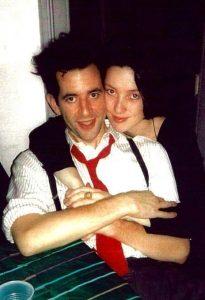
Jonathan Larson and Victoria Leacock
Known back then simply as “Victoria Leacock” (“Hoffman” is her married name), she produced all of Larson’s work prior to Rent. On a shoestring budget, she managed to get him as much exposure as possible for a young “unknown” aspiring composer and playwright, who was busy writing songs and shows, just hoping for a break.
Jonathan Larson spent about seven years writing the book, music, and lyrics for Rent–a starving artist, working at the Moondance Diner in NYC to help pay the bills. (I admired very much that dedication, as well as the passion, kindness, drama, and social consciousness that filled his music.) He died of an aortic dissection–which two hospitals had failed to catch–the night before the first performance of Rent. He was only 35. (The black-and-white photo of him by himself that I’m posting was taken just hours or less before his death. All photos pertaining to Larson are posted courtesy of Victoria Leacock Hoffman.)
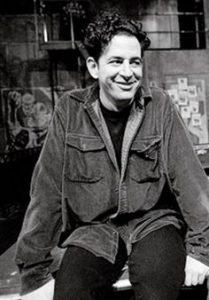
JONATHAN LARSON
Rent was the biggest hit of the era, earning hundreds of millions of dollars, internationally (as well as earning Larson, posthumously, the Tony Award and the Pulitzer Prize). Larson never saw any of that money during his lifetime. He did the work he was born to do, without receiving any real financial rewards. As a starving artist, he could never have afforded a posh nightclub like Feinstein’s/54 Below. His sympathies were always with the poor, and with outsiders in general. I very much like the fact that Feinstein’s/54 Below honored Larson’s memory by offering some rush tickets to The Jonathan Larson Project for just $20 (far below their usual prices) to make the show more affordable to more people. (Rent also always made some seats available at low prices, in keeping with Larson’s wishes.)
Jonathan Larson had a lot to give the world. I watched Rent quickly find a mass audience, in a way that happens perhaps once in a generation. It opened Off-Broadway, in 1996, with an explosive energy, and I happily watched the audience respond in kind. It soon transferred to Broadway. And it was the hot ticket–much the way Hamilton would be, about 20 years later. When I attended the recording session for the original cast album, the feeling in the air was really strong (and different from any other recording session I’ve attended); everyone knew the album would be a huge hit. Interest in Rent and Larson was red hot.
Everyone said it was a pity that Larson had only lived to complete one show. Few knew about the other shows and songs he’d worked on.
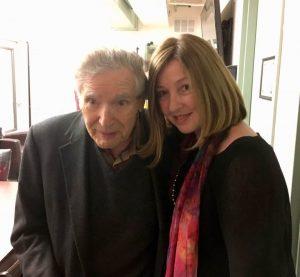
Al Larson and Victoria Leacock Hoffman
Victoria Leacock surprised everyone by getting another one of his shows, tick, tick… BOOM!, produced. Working with co-producer Robyn Goodman and others, she put her money and her energy into seeing that tick, tick… BOOM! got the best possible production. It found audiences in the U.S. and abroad and will shortly be turned into a motion picture. So now there were two Jonathan Larson musicals out there. And most people thought they’d seen/heard all that Jonathan Larson had left behind.
But this concert reminds us that he still has some good work that almost no one knows about. For example, his song “Greene Street”–which had never been publicly performed before this month’s presentations at Feinsteins/54 Below–is terrifically appealing. If a way could be found to use it in a musical, it might be the highlight of that musical.
I have no idea what hopes, dreams, or plans for these unknown songs the Larson family, Victoria Leacock Hoffman, Jennifer Ashley Tepper or others might have at this point. (I have not had a chance to ask anyone.) But I hope they’re thinking about doing more with some of this material. Because it’s clear that Larson left some very intriguing material behind. And songs like “Greene Street” and “Valentine’s Day” and “Piano” and “Destination Sky” deserve greater exposure. Even if it means constructing musicals to incorporate his songs. There’s a lot to think about.
But producing an album or two of his unknown songs might be a good next step.
– CHIP DEFFAA
October 28, 2018






Leave a comment